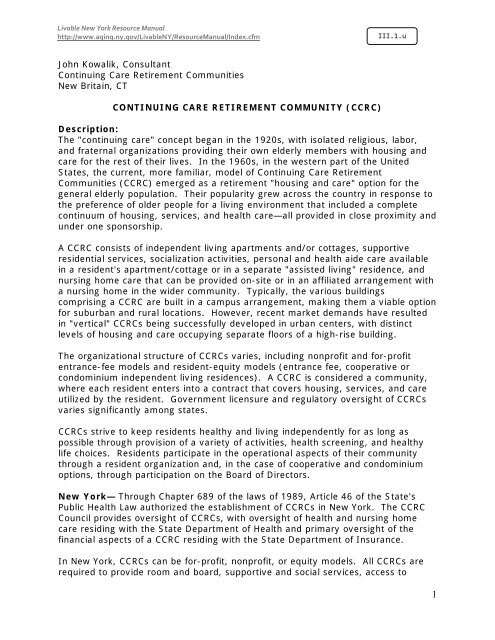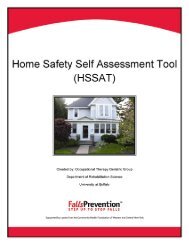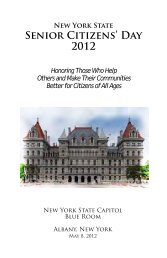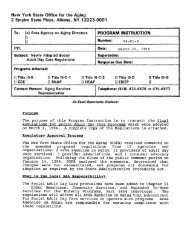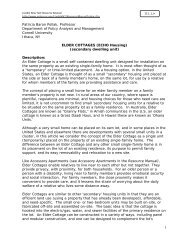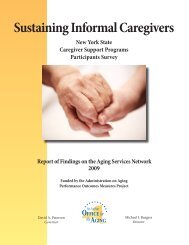continuing care retirement community - New York State Office for the ...
continuing care retirement community - New York State Office for the ...
continuing care retirement community - New York State Office for the ...
Create successful ePaper yourself
Turn your PDF publications into a flip-book with our unique Google optimized e-Paper software.
Livable <strong>New</strong> <strong>York</strong> Resource Manual<br />
http://www.aging.ny.gov/LivableNY/ResourceManual/Index.cfm<br />
III.1.u<br />
John Kowalik, Consultant<br />
Continuing Care Retirement Communities<br />
<strong>New</strong> Britain, CT<br />
CONTINUING CARE RETIREMENT COMMUNITY (CCRC)<br />
Description:<br />
The "<strong>continuing</strong> <strong>care</strong>" concept began in <strong>the</strong> 1920s, with isolated religious, labor,<br />
and fraternal organizations providing <strong>the</strong>ir own elderly members with housing and<br />
<strong>care</strong> <strong>for</strong> <strong>the</strong> rest of <strong>the</strong>ir lives. In <strong>the</strong> 1960s, in <strong>the</strong> western part of <strong>the</strong> United<br />
<strong>State</strong>s, <strong>the</strong> current, more familiar, model of Continuing Care Retirement<br />
Communities (CCRC) emerged as a <strong>retirement</strong> "housing and <strong>care</strong>" option <strong>for</strong> <strong>the</strong><br />
general elderly population. Their popularity grew across <strong>the</strong> country in response to<br />
<strong>the</strong> preference of older people <strong>for</strong> a living environment that included a complete<br />
continuum of housing, services, and health <strong>care</strong>—all provided in close proximity and<br />
under one sponsorship.<br />
A CCRC consists of independent living apartments and/or cottages, supportive<br />
residential services, socialization activities, personal and health aide <strong>care</strong> available<br />
in a resident's apartment/cottage or in a separate "assisted living" residence, and<br />
nursing home <strong>care</strong> that can be provided on-site or in an affiliated arrangement with<br />
a nursing home in <strong>the</strong> wider <strong>community</strong>. Typically, <strong>the</strong> various buildings<br />
comprising a CCRC are built in a campus arrangement, making <strong>the</strong>m a viable option<br />
<strong>for</strong> suburban and rural locations. However, recent market demands have resulted<br />
in "vertical" CCRCs being successfully developed in urban centers, with distinct<br />
levels of housing and <strong>care</strong> occupying separate floors of a high-rise building.<br />
The organizational structure of CCRCs varies, including nonprofit and <strong>for</strong>-profit<br />
entrance-fee models and resident-equity models (entrance fee, cooperative or<br />
condominium independent living residences). A CCRC is considered a <strong>community</strong>,<br />
where each resident enters into a contract that covers housing, services, and <strong>care</strong><br />
utilized by <strong>the</strong> resident. Government licensure and regulatory oversight of CCRCs<br />
varies significantly among states.<br />
CCRCs strive to keep residents healthy and living independently <strong>for</strong> as long as<br />
possible through provision of a variety of activities, health screening, and healthy<br />
life choices. Residents participate in <strong>the</strong> operational aspects of <strong>the</strong>ir <strong>community</strong><br />
through a resident organization and, in <strong>the</strong> case of cooperative and condominium<br />
options, through participation on <strong>the</strong> Board of Directors.<br />
<strong>New</strong> <strong>York</strong>— Through Chapter 689 of <strong>the</strong> laws of 1989, Article 46 of <strong>the</strong> <strong>State</strong>'s<br />
Public Health Law authorized <strong>the</strong> establishment of CCRCs in <strong>New</strong> <strong>York</strong>. The CCRC<br />
Council provides oversight of CCRCs, with oversight of health and nursing home<br />
<strong>care</strong> residing with <strong>the</strong> <strong>State</strong> Department of Health and primary oversight of <strong>the</strong><br />
financial aspects of a CCRC residing with <strong>the</strong> <strong>State</strong> Department of Insurance.<br />
In <strong>New</strong> <strong>York</strong>, CCRCs can be <strong>for</strong>-profit, nonprofit, or equity models. All CCRCs are<br />
required to provide room and board, supportive and social services, access to<br />
1
Livable <strong>New</strong> <strong>York</strong> Resource Manual<br />
http://www.aging.ny.gov/LivableNY/ResourceManual/Index.cfm<br />
III.1.u<br />
personal and health <strong>care</strong>, and nursing home <strong>care</strong> as part of <strong>the</strong> resident's contract<br />
in exchange <strong>for</strong> payment of an entrance fee and monthly fees. In <strong>the</strong> case of an<br />
equity CCRC, a resident purchases <strong>the</strong> independent living residence as a<br />
condominium or cooperative, with <strong>the</strong> purchase price serving as <strong>the</strong> entrance fee.<br />
CCRC contracts will specify whe<strong>the</strong>r any portion of <strong>the</strong> entrance fee is refundable to<br />
<strong>the</strong> resident (or <strong>the</strong> resident's estate) upon cancellation of <strong>the</strong> contract, with<br />
refunds of 50 to 90 per cent of <strong>the</strong> original entrance fee a common practice. Upon<br />
sale of a cooperative or condominium in an equity CCRC, residents (or <strong>the</strong>ir<br />
estates) receive <strong>the</strong> sale price as well as any appreciation in <strong>the</strong> real estate value of<br />
<strong>the</strong> independent living unit. <strong>New</strong> <strong>York</strong> <strong>State</strong> requires that all refunds be made upon<br />
resale of <strong>the</strong> residence or one year's time following cancellation of <strong>the</strong> contract,<br />
whichever is sooner.<br />
There are three types of CCRC resident contracts allowed in <strong>New</strong> <strong>York</strong>, and many<br />
CCRCs offer more than one type as choices to residents:<br />
• Type A (life <strong>care</strong>) contract: All nursing home <strong>care</strong> is provided as needed during<br />
<strong>the</strong> resident’s lifetime, and <strong>the</strong> resident's monthly charges in <strong>the</strong> nursing home<br />
do not increase as his/her level of <strong>care</strong> increases, but remains <strong>the</strong> same as that<br />
paid by <strong>the</strong> resident if he/she were living in <strong>the</strong> independent living residence.<br />
• Type B (modified) contract: A limited amount of nursing home <strong>care</strong> (specified in<br />
<strong>the</strong> resident's contract) is available to <strong>the</strong> resident, at <strong>the</strong> same monthly charge<br />
as was paid in <strong>the</strong> independent living residence; and any additional nursing<br />
home <strong>care</strong> is charged at a per diem rate. <strong>New</strong> <strong>York</strong> law requires a minimum of<br />
sixty nursing home days at <strong>the</strong> same monthly fee as paid in <strong>the</strong> independent<br />
living residence, although CCRCs may choose to offer contracts that provide<br />
additional coverage at that same amount.<br />
• Type C (fee-<strong>for</strong>-service) contract: The resident's contract does not include <strong>the</strong><br />
provision of nursing home <strong>care</strong>, and residents are required to pay a per diem<br />
rate <strong>for</strong> any nursing <strong>care</strong> as it is needed.<br />
Benefits:<br />
For residents:<br />
• Various models, contract types, and refund policies have an impact on <strong>the</strong><br />
amount of entrance fees and monthly fees charged; most CCRCs offer more<br />
than one contract option, <strong>the</strong>reby providing each resident with choices to better<br />
match his/her preferences and financial status.<br />
• Life <strong>care</strong> contracts (a long-term <strong>care</strong> insurance concept) provide peace of mind<br />
<strong>for</strong> residents and <strong>the</strong>ir families by assuring that a continuum of appropriate <strong>care</strong><br />
will be available and af<strong>for</strong>dable when needed, while minimizing or eliminating<br />
<strong>the</strong> trauma of relocation as frailties increase.<br />
• Residents find a com<strong>for</strong>t level in knowing exactly who will be providing <strong>the</strong>ir <strong>care</strong><br />
when it is needed.<br />
2
Livable <strong>New</strong> <strong>York</strong> Resource Manual<br />
http://www.aging.ny.gov/LivableNY/ResourceManual/Index.cfm<br />
III.1.u<br />
• Residents are not impoverished, as communities must guarantee that each<br />
contract holder will be <strong>care</strong>d <strong>for</strong> by <strong>the</strong> <strong>community</strong> even if a resident's assets are<br />
depleted.<br />
• Long-term nursing <strong>care</strong> is typically provided on <strong>the</strong> same campus so that <strong>the</strong><br />
resident stays within <strong>the</strong> <strong>community</strong>, among familiar surroundings, and with<br />
easy access by <strong>the</strong>ir spouse and friends.<br />
• Communities respond in emergency situations and can easily arrange <strong>for</strong><br />
resident health services and <strong>care</strong> planning as needed, freeing residents and <strong>the</strong>ir<br />
families from those tasks.<br />
• CCRCs generally have a high level of staffing, allowing <strong>for</strong> upscale services,<br />
including those provided in <strong>the</strong> long-term <strong>care</strong> setting.<br />
• Residents retain <strong>the</strong>ir ability to use private long-term <strong>care</strong> insurance, if <strong>the</strong>y so<br />
choose.<br />
• Transportation, residence cleaning and maintenance, social/cultural activities,<br />
health screening, and o<strong>the</strong>r preventative services are normally provided or<br />
arranged by <strong>the</strong> <strong>community</strong> <strong>for</strong> residents at little or no additional cost.<br />
• Refundable-entrance-fee contracts allow CCRC residents to preserve assets <strong>for</strong><br />
<strong>the</strong>ir heirs.<br />
• The continuum of housing and <strong>care</strong> provides a resident's family with peace of<br />
mind regarding a frail resident's on-going safety, <strong>care</strong>, and supervision . . . as<br />
well as a com<strong>for</strong>t level that <strong>the</strong>ir own <strong>care</strong> giving ef<strong>for</strong>ts will be consistently<br />
supplemented by <strong>the</strong> CCRC's services and <strong>care</strong>.<br />
For <strong>the</strong> state/locality:<br />
• Substantial job creation and use of local resources . . . during development and<br />
<strong>continuing</strong> during operations.<br />
• For-profit CCRCs make major contributions to <strong>the</strong> property and school tax base<br />
of <strong>the</strong> surrounding <strong>community</strong>.<br />
• Affluent residents remain in <strong>the</strong> <strong>State</strong>, contributing to both state and local<br />
economies.<br />
• CCRCs make a special ef<strong>for</strong>t to maintain <strong>the</strong> integration of <strong>the</strong>ir residents with<br />
<strong>the</strong> wider <strong>community</strong>; thus, residents contribute substantial time, ef<strong>for</strong>t, and<br />
financial support to many civic, intergenerational, and o<strong>the</strong>r projects in <strong>the</strong><br />
wider <strong>community</strong>.<br />
• CCRC residents do not divest <strong>the</strong>mselves of assets <strong>for</strong> Medicaid eligibility.<br />
• CCRCs are a successful model <strong>for</strong> rural, suburban, and urban areas.<br />
3
Livable <strong>New</strong> <strong>York</strong> Resource Manual<br />
http://www.aging.ny.gov/LivableNY/ResourceManual/Index.cfm<br />
III.1.u<br />
Impediments or barriers to development or implementation:<br />
• Lack of <strong>continuing</strong> bonding authority <strong>for</strong> <strong>the</strong> development phase:<br />
• Industrial Development Agency (IDA) authority to issue tax-free bonds<br />
lapses periodically, making financing uncertain, delaying <strong>the</strong> start of new<br />
CCRC communities, or requiring more costly financing sources, all of which<br />
increase residents' entrance fees and monthly charges.<br />
• No authority <strong>for</strong> <strong>the</strong> Dormitory Authority to issue unrated bonds <strong>for</strong> CCRCs.<br />
• Lack of af<strong>for</strong>dable seed capital – sponsors are unable to obtain bond anticipation<br />
notes, although allowed by existing legislation. High cost of seed capital<br />
increases resident fees.<br />
• Excessive regulatory oversight:<br />
• Two <strong>State</strong> agencies (Department of Health; Department of Insurance) review<br />
applications of entrance-fee models, and three <strong>State</strong> agencies (Department<br />
of Health; Department of Insurance; <strong>Office</strong> of <strong>the</strong> Attorney General) review<br />
applications of equity models. The resulting review process delays<br />
application approvals.<br />
• <strong>State</strong> Insurance Department micromanagement of <strong>community</strong> operations,<br />
contracts, fee changes, investments.<br />
• Lengthy process <strong>for</strong> updating resident contracts.<br />
• Unique <strong>New</strong> <strong>York</strong> <strong>State</strong> requirements make establishment and operation of<br />
CCRCs more expensive than in o<strong>the</strong>r <strong>State</strong>s:<br />
• Unique actuarial requirements;<br />
• Investment restrictions;<br />
• Restricted use of deposits <strong>for</strong> construction;<br />
• Application and finance delays require additional seed capital.<br />
• Inability of CCRCs to accept outside residents into <strong>the</strong> <strong>community</strong>'s nursing<br />
home and assisted living residence on a <strong>continuing</strong> basis increases resident fees.<br />
• Unfamiliarity with <strong>the</strong> CCRC concept by potential sponsors and prospective<br />
residents throughout <strong>New</strong> <strong>York</strong> <strong>State</strong>.<br />
• A discouraging business climate <strong>for</strong> CCRC development due to local zoning<br />
restrictions, development-financing sunsets, and lack of payment-in-lieu-oftaxes<br />
(PILOT) agreements.<br />
Resource—laws and regulations:<br />
• <strong>New</strong> <strong>York</strong> <strong>State</strong> Public Health Law:<br />
• <strong>New</strong> <strong>York</strong> Public Health, Article 46, §4600-4624, "Continuing Care Retirement<br />
Communities," onecle on line: http://law.onecle.com/new-york/publichealth/article46.html.<br />
4
Livable <strong>New</strong> <strong>York</strong> Resource Manual<br />
http://www.aging.ny.gov/LivableNY/ResourceManual/Index.cfm<br />
III.1.u<br />
Also: "Article 46 - (4600 - 4624) Continuing Care Retirement Communities,"<br />
Attorney.org on line: http://statutes.attorney.org/new-york/pbh/article-46.<br />
• "<strong>New</strong> <strong>York</strong> Public Health, Article 46A, §4650-4676, Fee <strong>for</strong> Service Continuing<br />
Care Retirement Community Demonstration Program," onecle on line:<br />
http://law.onecle.com/new-york/public-health/article46-a.html.<br />
• Westlaw, <strong>New</strong> <strong>York</strong> <strong>State</strong> Department of <strong>State</strong>, Division of Administrative<br />
Rules—to find <strong>the</strong> regulations governing Continuing Care Retirement<br />
Communities: NYCRR, Title 10 (<strong>New</strong> <strong>York</strong> <strong>State</strong> Department of Health), Part<br />
900 (Certificate of Authority), Chapter VII (Life Care Communities):<br />
http://w3.health.state.ny.us/dbspace/NYCRR10.nsf/56cf2e25d626f9f785256<br />
538006c3ed7?SearchView: in <strong>the</strong> search slot, type "Part 900."<br />
Resource—examples (one co-op; <strong>the</strong> rest are entrance fee communities):<br />
• Peconic Landing (<strong>the</strong> <strong>State</strong>’s only cooperative CCRC), Greenport, NY, Suffolk<br />
County, www.peconiclanding.org.<br />
• Canterbury Woods, Amherst, NY, Erie County, www.canterburywoods.org.<br />
• Kendal at Ithaca, Ithaca, NY, Tompkins County, www.kai.kendal.org.<br />
• Glen Arden, Goshen, NY, Orange County, http://elant.org.<br />
• Summit at Brighton, Brighton, NY, Monroe County, www.jewishseniorlife.org.<br />
• Jefferson's Ferry, South Setauket, NY, Suffolk County, www.jeffersonsferry.org.<br />
• Westchester Meadows, Valhalla, NY, Westchester County,<br />
www.westchestermeadows.org.<br />
• Kendal on Hudson, Sleepy Hollow, NY, Westchester County,<br />
www.kohud.kendal.org.<br />
Resource—written and web:<br />
• Continuing Care Accreditation Commission (CCAC), a national organization<br />
which is now part of <strong>the</strong> national Commission on Accreditation of Rehabilitation<br />
Facilities (CARF). CCAC is <strong>the</strong> nation's only accrediting body <strong>for</strong> CCRCs.<br />
http://www.carf.org. On <strong>the</strong> home page, choose CARF-CCAC on <strong>the</strong> menu on<br />
<strong>the</strong> left.<br />
• Sarah Mashburn (March 22, 2011), "Fact Sheet: What You Need to Know About<br />
CCRCs," Aging Services—What You Need to Know About CCRCs. Washington,<br />
DC: LeadingAge. http://www.leadingage.org/Article.aspx?id=205.<br />
• Perry Edelman and Jan Montague (April, 2008). "Wellnessness: First National<br />
Survey Identifies Changing Expectations <strong>for</strong> LTC," Long-Term Living, Vol. 57,<br />
No. 4: http://ma<strong>the</strong>rlifeways.com/archives/337. Findings of a national survey of<br />
CCRCs conducted February, 2005, through May, 2006, by Ma<strong>the</strong>r LifeWays<br />
5
Livable <strong>New</strong> <strong>York</strong> Resource Manual<br />
http://www.aging.ny.gov/LivableNY/ResourceManual/Index.cfm<br />
III.1.u<br />
Institute on Aging, Dorsky Hodgson Parrish Yue (architectural firm), and Ziegler<br />
Capital Markets Group (financial services company <strong>for</strong> senior living projects).<br />
• Continuing Care Accreditation Commission (2007). Consumer Guide to<br />
Understanding Financial Per<strong>for</strong>mance and Reporting in Continuing Care<br />
Retirement Communities. Washington, DC: Commission on Accreditation of<br />
Rehabilitation Facilities.<br />
• John Harrigan, Jennifer Raiser, and Phillip Raiser (1998). Senior Residences:<br />
Designing Retirement Communities <strong>for</strong> <strong>the</strong> Future (Wiley Series in Health<strong>care</strong><br />
and Senior Living Design). <strong>New</strong> <strong>York</strong> City: Wiley Publishing.<br />
• CCRCs are available in Canada and <strong>the</strong> United Kingdom. The following book is a<br />
guide <strong>for</strong> use by developers who are designing and developing CCRCs in<br />
England: Robin Tetlow (2006): Continuing Care Retirement Communities: A<br />
Guide to Planning. <strong>York</strong>, United Kingdom: Joseph Rowntree Foundation. A PDF<br />
version of this publication can be viewed at:<br />
http://www.jrf.org.uk/sites/files/jrf/9781859354544.pdf.<br />
Resource (free or fee-based)—technical assistance contact names:<br />
• John Kowalik, Consultant<br />
Continuing Care Retirement Communities<br />
188 Gold Street<br />
<strong>New</strong> Britain, Connecticut, 06053<br />
(860) 826-1120<br />
• Ken Harris, Director<br />
Center <strong>for</strong> Senior Living and Community Services<br />
<strong>New</strong> <strong>York</strong> Association of Homes and Services <strong>for</strong> <strong>the</strong> Aging<br />
150 <strong>State</strong> Street, Albany, NY, 12207<br />
(518) 449-2707<br />
kharris@nyahsa.org<br />
• Loretta Grose<br />
Bureau of Continuing Care Initiatives<br />
<strong>New</strong> <strong>York</strong> <strong>State</strong> Department of Health<br />
Corning Tower<br />
Empire <strong>State</strong> Plaza<br />
Albany, NY, 12237<br />
(518) 474-6965<br />
lrg02@health.state.ny.us<br />
6


